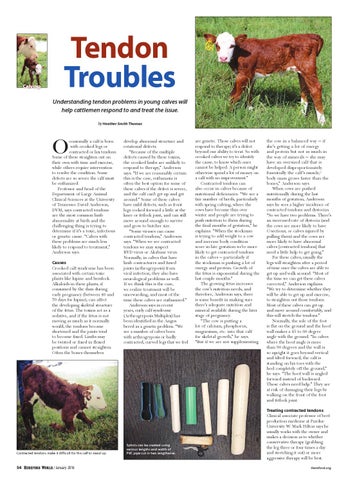Calving
Tendon Troubles Understanding tendon problems in young calves will help cattlemen respond to and treat the issue. by Heather Smith Thomas
O
ccasionally a calf is born with crooked legs or contracted or lax tendons. Some of these straighten out on their own with time and exercise, while others require intervention to resolve the condition. Some defects are so severe the calf must be euthanized. Professor and head of the Department of Large Animal Clinical Sciences at the University of Tennessee David Anderson, DVM, says contracted tendons are the most common limb abnormality at birth and the challenging thing is trying to determine if it’s a toxic, infectious or genetic cause. “Calves with these problems are much less likely to respond to treatment,” Anderson says.
Causes Crooked calf syndrome has been associated with certain toxic plants like lupine and hemlock. Alkaloids in these plants, if consumed by the dam during early pregnancy (between 40 and 70 days for lupine), can affect the developing skeletal structure of the fetus. The toxins act as a sedative, and if the fetus is not moving as much as it normally would, the tendons become shortened and the joints tend to become fixed. Limbs may be twisted or fixed in flexed positions and cannot straighten. Often the bones themselves
develop abnormal structure and rotational defects. “Because of the multiple defects caused by these toxins, the crooked limbs are unlikely to respond to therapy,” Anderson says. “If we are reasonably certain this is the case, euthanasia is often the best option for some of these calves if the defect is severe, and the calf can’t get up and get around.” Some of these calves have mild defects, such as front legs cocked forward a little at the knee or fetlock joint, and can still move around enough to survive and grow to butcher size. “Some viruses can cause contracted tendons,” Anderson says. “When we see contracted tendons we may suspect BVD virus or Akabane virus. Normally, in calves that have limb contractures and fused joints (arthrogryposis) from viral infection, they also have neurological problems as well. If we think this is the case, we realize treatment will be unrewarding, and most of the time these calves are euthanized.” Anderson says in recent years, curly calf syndrome (Arthrogryposis Multiplex) has been identified in the Angus breed as a genetic problem. “We see a number of calves born with arthrogryposis or badly contracted, curved legs that we feel
are genetic. Those calves will not respond to therapy; it’s a defect beyond our ability to treat. So with crooked calves we try to identify the cause, to know which ones cannot be helped. A person might otherwise spend a lot of money on a calf with no improvement.” Contracted tendons can also occur in calves because of nutritional deficiencies. “We see a fair number of herds, particularly with spring calving, where the cows have become thin over winter and people are trying to push nutrition to them during the final months of gestation,” he explains. “When the stockman is trying to add weight to a cow and increase body condition score in late gestation we’re more likely to get contracted tendons in the calves — particularly if the stockman is pushing a lot of energy and protein. Growth of the fetus is exponential during the last couple months.” The growing fetus increases the cow’s nutrition needs, and therefore, Anderson says, there is some benefit in making sure there’s adequate nutrition and mineral available during the later stage of pregnancy. “The cow is putting a lot of calcium, phosphorus, magnesium, etc. into that calf for skeletal growth,” he says. “But if we are not supplementing
the cow in a balanced way — if she’s getting a lot of energy and protein but not as much in the way of minerals — she may have an oversized calf that is developed disproportionately. Essentially the calf’s muscle/ body mass grows faster than the bones,” Anderson says. When cows are pushed nutritionally during the last months of gestation, Anderson says he sees a higher incidence of contracted tendons and dystocias. “So we have two problems. There’s an increased rate of dystocia (and the cows are more likely to have C-sections, or calves injured by pulling them) and the cows are more likely to have abnormal calves [contracted tendons] that need a little help to get going.” For these calves, usually the legs will straighten after a period of time once the calves are able to get up and walk around. “Most of the time we can get these calves corrected,” Anderson explains. “We try to determine whether they will be able to get up and exercise, to straighten out those tendons. Most of these calves can get up and move around comfortably, and this will stretch the tendons.” Normally, the sole of the foot is flat on the ground and the hoof wall makes a 45 to 60 degree angle with the ground. “In calves where the hoof angle is more than 90 degrees and the wall is so upright it goes beyond vertical and tilted forward, the calf is standing on his toes with the heel completely off the ground,” he says. “The hoof wall is angled forward instead of backward. Those calves need help.” They are at risk of damaging their legs by walking on the front of the foot and fetlock joint.
Treating contracted tendons
Contracted tendons make it difficult for this calf to stand up.
54
/ January 2016
Splints can be created using various lengths and width of PVC pipe cut in two lengthwise.
Clinical associate professor of beef production medicine at Purdue University W. Mark Hilton says he usually works with the owner and makes a decision as to whether conservative therapy (grabbing the leg three or four times a day and stretching it out) or more aggressive therapy will be best. Hereford.org
